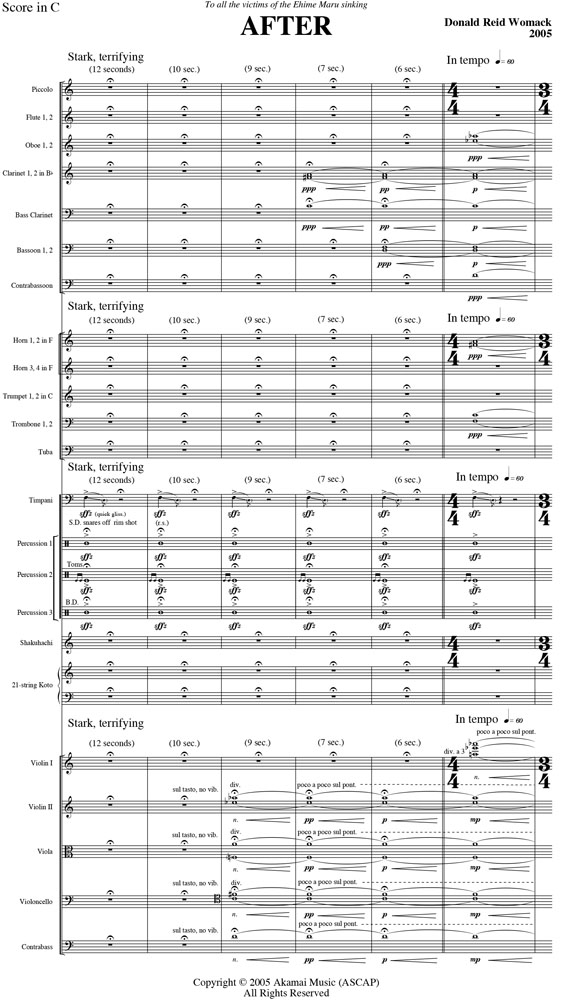After
concerto for shakuhachi & koto
Price range: $35.00 through $700.00
shakuhachi, 21-string koto & orchestra
(3233 4221 Timp 3 Prc strings)
尺八と二十絃箏のための協奏曲
33:00
25:00
Commissioned by Honolulu Symphony Orchestra
On February 9, 2001 the U.S.S. Greeneville, a United States Navy submarine, collided with the Japanese fishing vessel Ehime Maru off the coast of Oahu, sinking it and killing nine of its crew. The tragedy of that day was felt sharply on both sides of the Pacific, as international relations were strained and individual lives were ruined. It is on the level of the latter that this incident resonated in me. I tried to envision what it must have been like to experience the initial shock of the collision, for the men and boys on board the Ehime Maru, for their families and friends upon receiving the news, and for the American sailors on board the Greeneville. I imagined the various emotional stages those involved must have gone through—terror and chaos, denial, numbness, anger, intense grief, resignation, and eventually perhaps acceptance.
While the piece was inspired by this specific incident, it goes beyond this one event to touch more broadly on the human experience of loss and healing, which affects all of us. Sometimes in small ways, sometimes in very significant ways, undergoing the cycle of emotional loss and healing is part of what it means to be human. After is ultimately about a fundamental emotional experience that we all share, one that ties us together and—if we recognize and embrace it as a shared experience—can enable us to better understand each other. After is about how we deal with grief.
The title of the piece refers to those emotions, the experience after the event. The normal human response to any loss is a complex progression through several stages of grief. Far from being simple and systematic, however, in reality this progression is neither smooth nor predictable. Imagining the emotional journey that is grief compelled me to create a work that mirrors this complex experience.
In honor of the Ehime Maru crew members who lost their lives, the number nine is imbedded in the structure of the work, with musical elements on many levels appearing nine times. The piece begins with the initial shock of the event, sudden and unexpected. This shock is iterated nine times with increasing intensity, leading to a section of terror, chaos, and disorientation, as is felt at a moment of sudden loss. Once the initial terror has receded, the complex process of sorting through emotional reactions begins, with successive sections progressing through different emotional states. Various contrasting passages are alternately chaotic and lyrical, angry and reflective, mournful and hopeful. Eventually, after a series of climaxes, the music gently dissipates with a quiet cadenza for koto and shakuhachi, finally drifting away to a faint echo of the opening nine strikes.
A year after the Ehime Maru sinking, survivor Daisuke Shinoto said “I want the people of Hawai‘i and the U.S. Navy not to forget about all the victims and the accident of the Ehime Maru.”
Ultimately my hope is that this work will not only honor the lives affected by this tragic incident and help us all remember it, but also help us understand each other better through the shared experience of loss and healing.
“In this well-structured work, with rhythmic and motivic motion and a Japanese emotional character, the continuing tension and moving sound and the gentle and quiet sections given to shakuhachi and koto are musically executed for 35 minutes, with the relation between motion and stillness skillfully handled. (On a concert featuring several of Japan’s most venerated composers) it was the most rewarding piece.”
— Ongaku no Tomo in its review of the Tokyo Metropolitan Symphony’s Japan premiere

